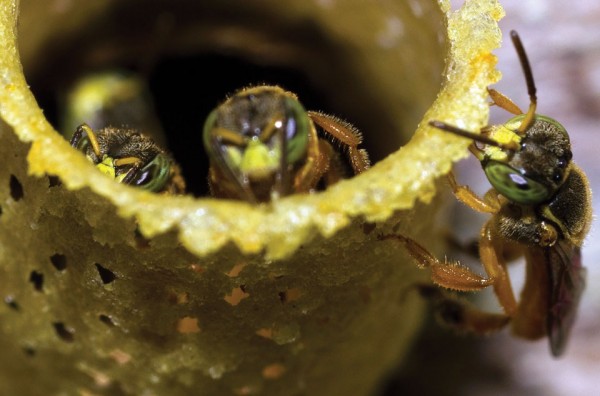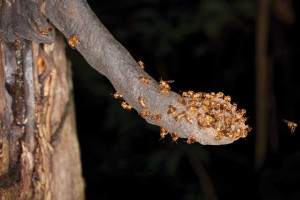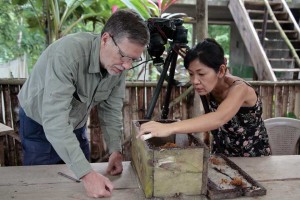Stingless Bees of the Maya
Written by. Dr. Nicholas M. Hellmuth
My first encounter with stingless bees came at age 19, when I spent 12 months at Tikal, doing archaeological field work. You see and experience stingless bees in most of the well-preserved Maya palaces, especially the back rooms of Maler’s Palace.
About 47 years later, I revisited stingless bees at Tikal while studying the biodiversity of Tikal under national park staff biologist Mirtha Cano.
A year later it was possible to study more stingless bees in the Río Dulce area of the Department of Izabal. I was introduced by Kevin Lock to several places where we could study these bees, especially on the property of Richard Bronson. I also became acquainted with Scott Forsythe who, in turn, introduced me to Masaki, a Japanese lady who has stingless bees in the property at her posada in Quiriguá. Stingless bees are also doing well at Finca Buenos Aires, Takalik Abaj with Ing. Carlos Guzman, a member of the Asociación de Reservas Privadas de Guatemala.
Our staff members noticed stingless bees building their typical entrance tube right in front of the FLAAR ethnobotany and ethnozoological research center (at 1,500 meters elevation in Guatemala). At the FLAAR facilities we raise butterflies, using no cages or anything artificial. The secret? Don’t use insecticide in your garden. Our entire eco-system is natural, yet we’re in the middle of a city. If we had property in the countryside, we would raise a veritable zoo.
In part, my enjoyment of bees is watching them build their entrance-exit tube and seeing them hover in front of the hive, getting ready to dive down the tube. It makes me think of sci-fi movies with alien spaceships, fighter planes and helicopter-like scout planes hovering around the entrance port to the mother ship.
Aside from images of bees and alien worlds, for thousands of years bees were an important economic aspect of Classic Maya civilization. And beekeeping is still important in Maya areas today, though unfortunately modern bees tend to replace indigenous species more and more every year.
The more common species of stingless bees are very tiny. You will recognize these little bees in many flower-filled gardens.
Mirta Cano has shown me that several species make their nest in the ground, so merely walking around can destroy their habitat.
Though these bees are stingless, they will attack if they feel threatened. The only time it happened to me was when my head was in the flight path of their hive (I was concentrating on photographing another hive about one meter below, on the same tree). When stingless bees get irritated, they dive into your head and burrow down through your hair and pester the daylights out of your scalp. They also buzz around your eyes and ears, but mainly it’s your scalp that gets the full bore of their wrath. What to do: Get away from their hive, immediately! And never wave your hands or arms to fend them off.
The bees in front of my house are accustomed to people walking around them all day. My guess is that these bees are simply used to the presence of people. This hive seems to have learned that we will neither attack them nor even disrupt them.
I hope this article raises awareness of stingless bees. We at FLAAR institute would be interested in working on projects if your company or foundation could provide funding. We would especially like to raise awareness throughout Guatemala in providing protection for stingless bees, and not obliterating them with insecticides nor cutting down the trees where some species make their hives.
Dr. Nicholas M. Hellmuth is director of FLAAR Reports (Foundation for Latin American Anthropological Research). Visit www.maya-archaeology.org or contact Dr. Hellmuth at frontdesk@flaar.org
For information about raising stingless bees as a hobby, you can contact Scott Forsythe (forsythe_scott@hotmail.com). If you’d like to see stingless bees in the Río Dulce area, contact kevinlock2001@yahoo.com. He can take you to visit the bees of Don Emilio (Emilio Mendizábal) in his property the Jardin botánico El Ciricote (about 15-minute drive north from Río Dulce).
If you are a biologist and wish to do research on stingless bees in Petén, contact the Parque Nacional Tikal. Biologist Mirta Cano would be a good starting point.
If you are a visitor to Guatemala, most local guides in Petén should be able to find you stingless bee hives, especially in Tikal. If you are in the Sayaxché area of El Petén, you can ask Julián Mariona of Posada El Caribe if he can find you stingless bees.
You can buy honey from stingless bees at Macaw Mountain a few kilometers from Copán Ruinas, Honduras (info@macawmountain.com).
Photographing stingless bees
We use a 21 megapixel Canon EOS-1Ds Mark III with a macro lens, either a 100mm macro or a Canon MP-E 65mm 1-5X macro lens. The latter is the best macro lens I have ever found for photographing insects, but you need eternal patience to get the lens close enough to focus.
It helps to have a ring flash or macro flash to allow you to freeze the flying bees so they are not too blurred in the photograph.
Since bees move rapidly bees are best photographed with HDSLR video, which means a high definition, single lens reflex camera (which means a camera where you can change your lenses, so ironically a camera which takes many lenses, not just one single lens).
We look forward to obtaining a brand new Canon EOS-1D X which is a pro-level camera but has video capabilities significantly better than any Canon Rebel or Nikon D-hundred series system. We appreciate John Lorusso, Parrot Digigraphic, www.ParrotColor.com, for providing cameras and lenses for our studies of the flora, fauna and archaeology museums of Guatemala.
Additional Reading:
– MARROQUÍN, A. 2000, Sistemática e historia natural de las abejas (Hymenoptera: Apoidea) de Guatemala.
Guatemala: Universidad de San Carlos, (Tesis de Graduación, Facultad de Ciencias Químicas y Farmacia)
– MICHENER, Charles Duncan 2000, The Bees of the World. Johns Hopkins University Press. 952 pages.
– ROUBIK, David 1992, Ecology and Natural History of Tropical Bees. Cambridge University Press. 528 pages.
– YURRITA, C., and Eunice ENRÍQUEZ 2005, Distribución de abejas sin aguijón en Guatemala. In Memorias del IV Seminario Mesoamericano sobre Abejas sin Aguijón. pgs 130–134.


